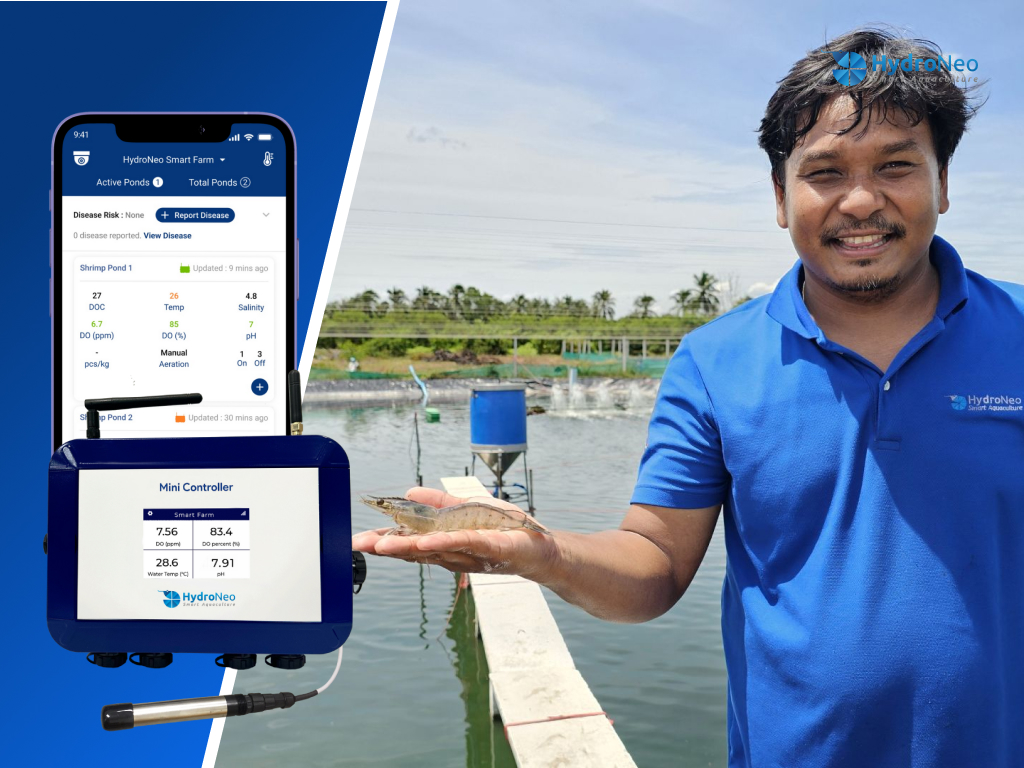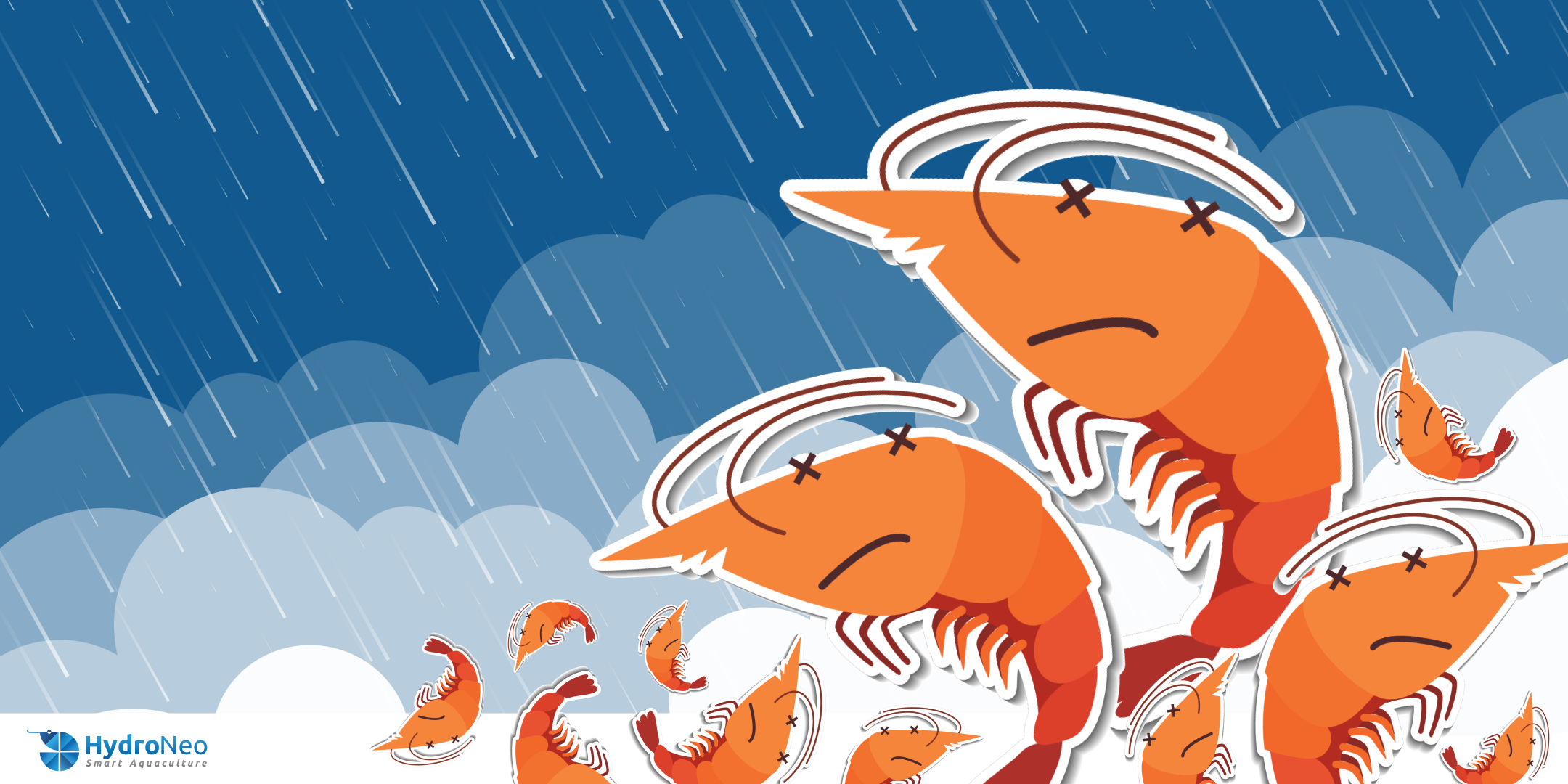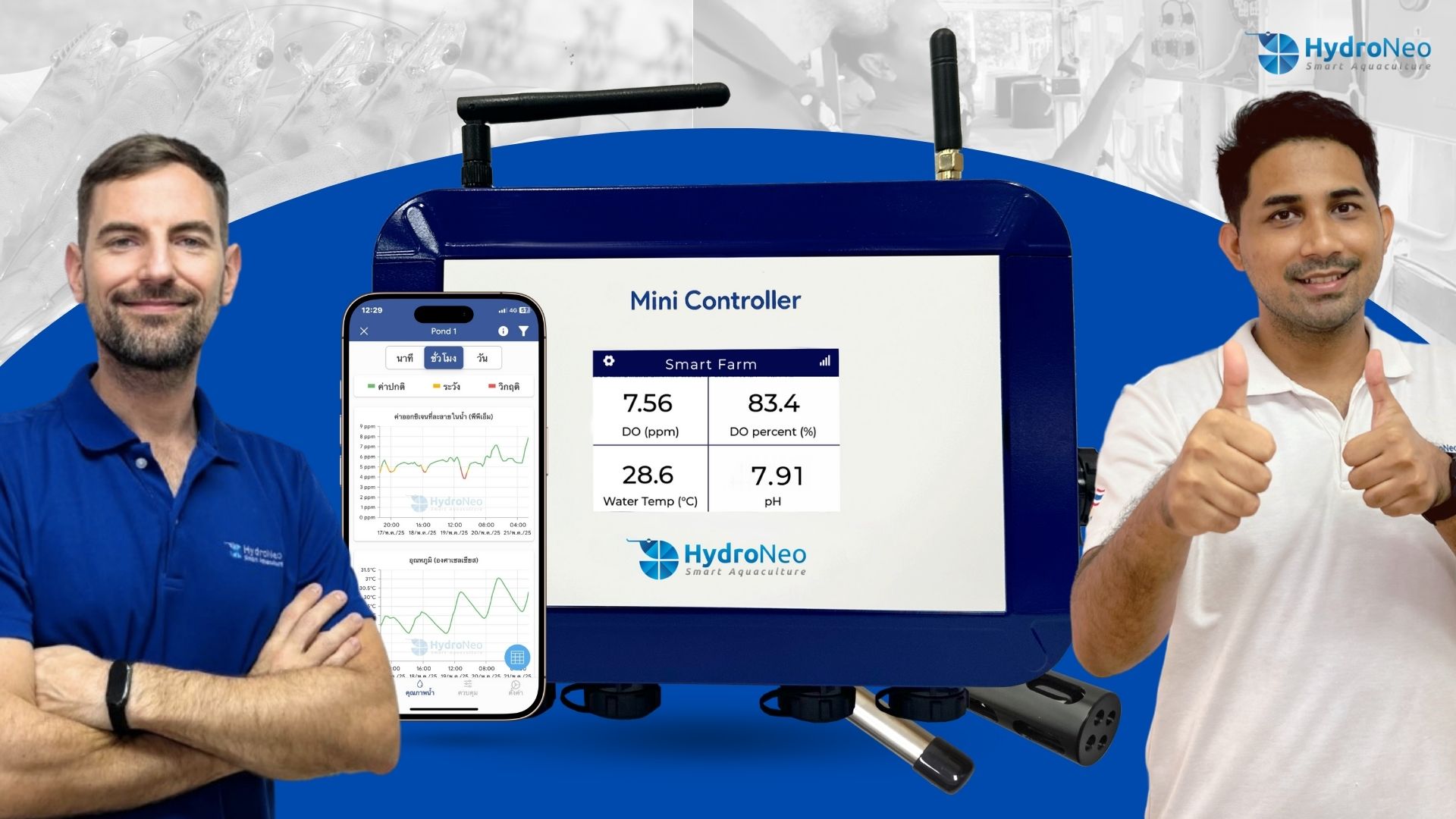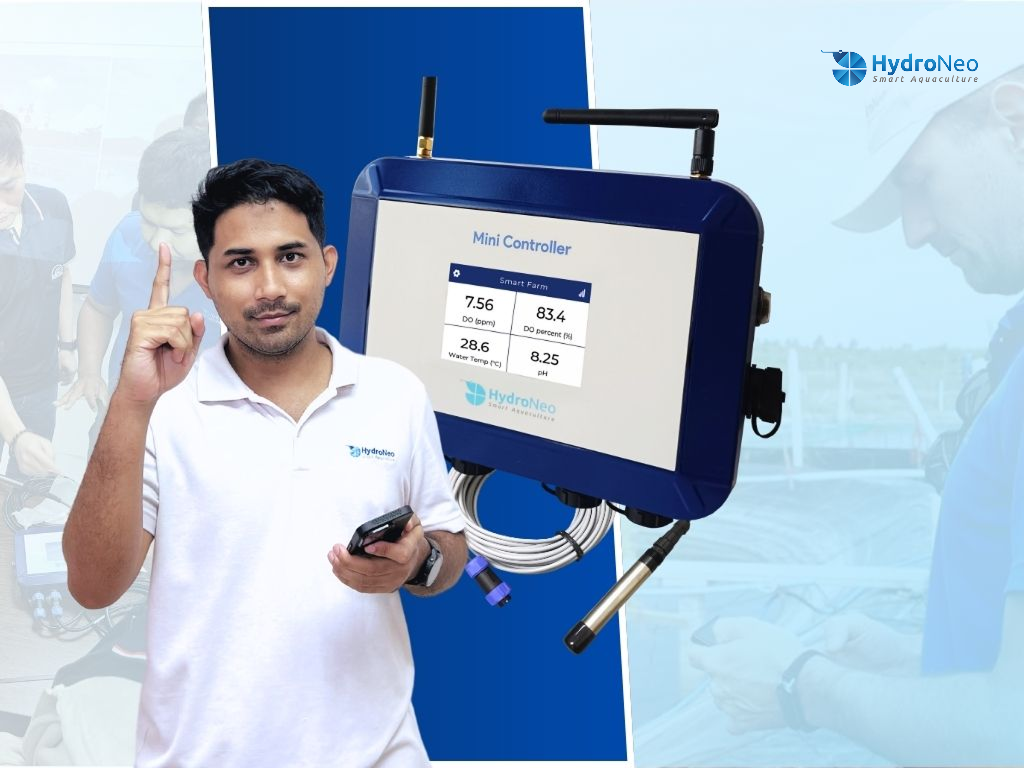การเปลี่ยนแปลงสภาพภูมิอากาศและการเพาะเลี้ยงสัตว์น้ำ: ความเสี่ยง ผลกระทบ และโซลูชันการทำฟาร์มอัจฉริยะ
การเพาะเลี้ยงสัตว์น้ำเป็นหนึ่งในภาคการผลิตอาหารที่เติบโตเร็วที่สุดในโลก ให้แหล่งโปรตีนที่ยั่งยืนและสร้างรายได้ให้กับผู้คนหลายล้านคนทั่วโลก องค์การอาหารและเกษตรแห่งสหประชาชาติ (FAO) ระบุว่าปัจจุบันการเพาะเลี้ยงสัตว์น้ำคิดเป็นเกือบ 46% ของการผลิตปลาทั่วโลกและมีแนวโน้มที่จะเพิ่มขึ้นเรื่อย ๆ
อย่างไรก็ตาม ภัยคุกคามจาก การเปลี่ยนแปลงสภาพภูมิอากาศ กำลังทำให้อนาคตของอุตสาหกรรมนี้ตกอยู่ในความเสี่ยง ทั้งอุณหภูมิน้ำที่สูงขึ้น คุณภาพน้ำที่เสื่อมลง และความไม่สมดุลของระบบนิเวศ ล้วนเป็นความท้าทายที่เกษตรกรผู้เลี้ยงปลาและกุ้งทั่วโลกต้องเผชิญ
การเปลี่ยนแปลงสภาพภูมิอากาศย่อยส่งผลต่อการเพาะเลี้ยงสัตว์น้ำ เเต่ด้วยเทคโนโลยีสมาร์ทฟาร์มจาก HydroNeo สามารถช่วยสร้างภูมิคุ้มกัน ความยั่งยืนและผลกำไรในระยะยาวได้
การเปลี่ยนแปลงสภาพภูมิอากาศส่งผลต่อการเพาะเลี้ยงสัตว์น้ำอย่างไร
ผลกระทบแบ่งออกได้เป็น โดยตรง และ โดยอ้อม
1. ผลกระทบโดยตรง
-
อุณหภูมิน้ำสูงขึ้น: น้ำที่อุ่นเกินไปส่งผลต่อการเจริญเติบโต การสืบพันธุ์ และภูมิคุ้มกันของปลาและกุ้ง โดยเฉพาะสัตว์น้ำที่ชอบน้ำเย็น เช่น แซลมอนและคอด ซึ่งมีความเสี่ยงต่อความเครียดจากความร้อน นำไปสู่การตายที่สูงขึ้น
-
ภาวะกรดในมหาสมุทร: การสะสมของ CO₂ ทำให้สัตว์น้ำที่สร้างเปลือกแข็ง (กุ้ง หอยนางรม หอยแมลงภู่) พัฒนาเปลือกได้ยากขึ้น ส่งผลต่อการรอดชีวิตและผลผลิต
-
ความเสี่ยงด้านโรคที่เพิ่มขึ้น: อุณหภูมิที่สูงขึ้นเอื้อต่อการแพร่กระจายของแบคทีเรีย ไวรัส และปรสิต ทำให้เกิดการระบาดของโรคบ่อยขึ้นและรุนแรงขึ้น
2. ผลกระทบโดยอ้อม
-
ความเสียสมดุลของระบบนิเวศ: การเปลี่ยนแปลงภูมิอากาศกระทบต่อพฤติกรรมและแหล่งอาหารของสัตว์น้ำ
-
คุณภาพน้ำเสื่อมลง: อุณหภูมิสูงทำให้ปริมาณออกซิเจนละลายน้ำลดลง ความเป็นกรดเพิ่มขึ้น และคุณภาพน้ำโดยรวมลดลง ทำให้สัตว์น้ำเครียดและผลผลิตลดลง
-
Rising Input Costsต้นทุนการผลิตสูงขึ้น: ผลกระทบต่อการประมงและการผลิตปลาป่นทำให้ค่าอาหารสัตว์และพลังงานเพิ่มขึ้น
ความยั่งยืนกับการเพาะเลี้ยงสัตว์น้ำในยุคสภาพอากาศเปลี่ยนแปลง
เพื่อให้การเพาะเลี้ยงสัตว์น้ำยังคงดำเนินต่อไปได้อย่างมีศักยภาพ ความยั่งยืนต้องเป็นหลักที่ยึดถือไว้ก่อนเสมอ
สิ่งแวดล้อม (Environmental)
-
ปกป้องความหลากหลายทางชีวภาพและระบบนิเวศ เช่น ป่าชายเลนและแนวปะการัง
-
ลดผลกระทบจากการทำฟาร์มต่อสิ่งแวดล้อม
เศรษฐกิจ (Economic)
-
รักษาต้นทุนการผลิตให้คุ้มค่า แม้ต้นทุนวัตถุดิบจะสูงขึ้น
-
สนับสนุนเกษตรกรรายย่อยด้วยโซลูชันอัจฉริยะเพื่อลดความเสี่ยง
สังคม (Social)
-
ส่งเสริมความมั่นคงทางอาหารและสร้างรายได้ในชนบท
-
ช่วยให้ชุมชนเกษตรกรปรับตัวกับการเปลี่ยนแปลงภูมิอากาศได้
กลยุทธ์การปรับตัวและการลดผลกระทบ
ผู้ผลิตสัตว์น้ำสามารถเสริมความแข็งแกร่งให้กับการดำเนินงานของตนได้ ด้วยการผสมผสานระหว่างกลยุทธ์การปรับตัวและการลดผลกระทบจากการเปลี่ยนแปลงสภาพภูมิอากาศ
กลยุทธ์การปรับตัว
-
กระจายรายได้: ผสมผสานการเพาะเลี้ยงสัตว์น้ำกับเกษตรกรรมหรือการท่องเที่ยวเชิงนิเวศ
-
ใช้สายพันธุ์ที่ทนทาน: คัดเลือกใช้สายพันธ์ุที่ทนร้อนหรือทนโรคได้ดี
-
บริหารจัดการน้ำขั้นสูง: ใช้เทคโนโลยีตรวจวัดคุณภาพน้ำแบบเรียลไทม์และพลังงานสะอาด เช่น โซลาร์เซลล์
-
ประกันความเสี่ยงมีระบบประกันภัยสำหรับเกษตรกรเพื่อลดผลกระทบจากภัยพิบัติและโรค
การลดผลกระทบ
-
ลดการปลดปล่อยก็าซคาร์บอน: ลดการปล่อยก๊าซเรือนกระจก โดยปรับปรุงประสิทธิภาพอาหารสัตว์ ใช้พลังงานสีเขียว และลดของเสีย
-
กักเก็บก๊าซคาร์บอน: สำรวจแนวทางการกักเก็บคาร์บอนโดยธรรมชาติ เช่น การเพาะเลี้ยงสาหร่ายร่วม
HydroNeo: สมาร์ทฟาร์มเพื่อการเพาะเลี้ยงสัตว์น้ำในยุคสภาพอากาศเปลี่ยนแปลง
HydroNeo กำลังก้าวนำในด้าน Precision Aquaculture ช่วยให้เกษตรกรกุ้งและปลาสามารถเฝ้าติดตามและปรับสภาพน้ำได้ด้วยข้อมูลเรียลไทม์
ทำไมต้องเลือก HydroNeo?
-
24/7 ตรวจวัดคุณภาพน้ำได้ 24/7 แบบเรียลไทม์
-
ตัดสินใจแม่นยำขึ้นจากข้อมูลจริง
-
ลดความเสี่ยงด้วยระบบแจ้งเตือนอัตโนมัติ
-
ป้องกันโรคได้ดียิ่งขึ้นด้วยเครื่องมือตรวจจับล่วงหน้า
-
สนับสนุนความยั่งยืนด้วยการลดการใช้พลังงานและของเสีย
ฟีเจอร์อัจฉริยะที่แตกต่าง
-
เซ็นเซอร์คุณภาพน้ำ (pH, DO, อุณหภูมิ ฯลฯ)
-
บันทึกภาพถ่ายเพื่อติดตามสุขภาพและการให้อาหาร
-
แดชบอร์ดวิเคราะห์ข้อมูลเพื่อวางแผนและเพิ่มผลผลิต
ทำฟาร์มอย่างชาญฉลาดไปกับ HydroNeo
แม้การเปลี่ยนแปลงสภาพภูมิอากาศจะเป็นความจริง แต่ด้วยเครื่องมือที่เหมาะสม เกษตรกรก็สามารถปรับตัว ปกป้องอาชีพ และเติบโตได้อย่างมั่นคง
-
ทนทานต่อความเสี่ยงจากสภาพภูมิอากาศ
-
มีประสิทธิภาพและทำกำไรได้สูงขึ้น
-
และยั่งยืนเพื่อคนรุ่นต่อไป
มาร่วมเดินหน้าสู่การเพาะเลี้ยงสัตว์น้ำเเบบอัจริยะ ที่ สอดคล้องกับสภาพภูมิอากาศ ไปด้วยกัน HydroNeo ช่วยเกษตรตรวจวัดคุณภาพน้ำได้ดียิ่งขึ้น วางแผนเเละตัดสินใจได้ชาญฉลาดขึ้น และเลี้ยงสัตว์น้ำได้อย่างมั่นใจ ไม่ว่าสภาพอากาศจะเปลี่ยนไปอย่างไร









